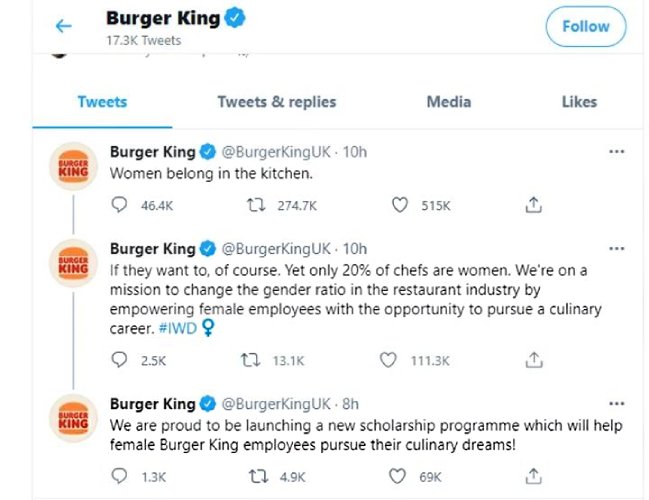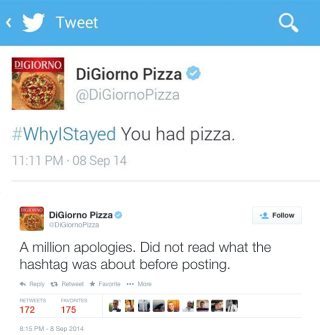How exactly does one define “social media?” Do we go as far as back as 1971 to the invention of the email, where Ray Tomlinson sent the first message across the network and initiated the use of the “@” sign? Or do we look as recently as 1997 to “SixDegrees.com,” one of the first platforms that allowed users to create public profiles and interact with one another? No matter which side of this debate you’re on, the only true constant that defines social media is the ability to connect with people online.
Traditional vs. Random Content
Many companies have a fundamental misunderstanding of the potential of social media. They use it strictly to drive traffic to their websites and to push their product. While this may work for some, others have employed a different approach to reach their audiences: “random content.”
Random content can quite literally be anything. From a funny knick-knack on a coworker’s desk to an office mishap, random content has the capacity to turn the seemingly inconsequential moments of the average workday into viral social media sensations, such as some of your favorite memes. While often lighthearted and funny, such content has been pivotal in internet culture, and some has even evolved to globally influential pieces of contemporary art.
Memes and Trends
From a marketer’s perspective, random content can help companies connect with their audiences on a level that most other tactics cannot. From a social media manager’s perspective, they are the perfect devices for filling your content pipeline and boosting engagement. However, companies must learn to strike a delicate balance between humor and professionalism. Random content—simple as it may be—should still align with your brand image and show that real people, not faceless corporate entities, are behind the posts. Offensive or discriminatory content can quickly backfire and derail your social media initiatives.
Success Stories
No social media strategy guarantees virality, but growth can be promoted by listening to your audiences and staying on top of trends. By paying close attention to the types of content that audiences are engaging with, your business can develop a comprehensive social media strategy that caters to the interests of users across your desired platforms. These are just a few examples of successful social media campaigns that have mastered the art of random content:

Los Angeles Chargers: The Los Angeles Chargers social media team is known for staying on top of trends and tailoring content to their young audience. A meme depicting their head coach jumping into the swimming pool at their new practice facility timely combines relatability and excitement for the upcoming football season.

Wendy’s: Notorious for their snarky tweets, Wendy’s has often found a way to promote their “Fresh, Never Frozen” beef products while simultaneously presenting themselves as humorous. Their willingness to poke fun at commentors without being mean-spirited resonates with their followers, as does their commitment to quality.
Duolingo: Even people who have no idea what Duolingo is can get enjoyment out of their funny posts featuring that green owl named Duo. As a language learning app that promotes daily usage, Duolingo frequently sends reminders to its users to work on their lessons. This has spawned a slew of internet memes in which the basic premise is that if you don’t do your lesson for the day, “Duo” will come get you no matter where you are.
Duolingo has no doubt seen this and decided to go along with it. This post capitalizes on that trend, as well as the “POV” trend that has seen much popularity on social media recently, making for brilliantly random content.
All these examples work for different reasons but have one thing in common. They listened to the audience. They recognized what people like and why. On top of this, it cost them almost nothing. With little more than the cost of labor, these posts reached tens of thousands of people, and they made them laugh while doing it. What sets these brands apart is not that they were fortunate enough to have content just happen in front of them, but that they were able to make something out of what would otherwise be completely forgettable. The essence of random content is being genuine, and social media users both notice and appreciate when there is passion in your company’s posts.
Trusting your social media team and collaborating with members from all generations—especially the internet natives—is the first step to an efficient social media campaign. The vast majority of young people use social media every day, so it is critical to listen to them. They know what is popular and how to emulate it. Corporate jargon gets lost in the crowd, but when a user sees a company posting the same kind of content that they would post themselves, it is meaningful to them.
What to Avoid
While the content may appear random, the execution still requires strategic thinking. While social media offers opportunities, it also poses risks. Bad decisions on social media spread like wildfire and can sometimes live on the internet in perpetuity. When constructing a social media strategy, it is vital that every avenue is considered. Examples of social media missteps include:

Home Depot: Although it is likely this was unintentional, this tweet conveyed a very racist implication. When conceptualizing social media content for your own organization, you must be aware of how it can be perceived. If there is any room for misinterpretation whatsoever, it might be better not to post at all.

Burger King: Promoting a scholarship program is one thing, but doing so by using a sexist phrase was undeniably inappropriate. The public response to this tweet highlights the importance of understanding the power of your words.

DiGiorno Pizza: Lack of research can lead to catastrophic results. In an attempt to be humorous, DiGiorno pizza unknowingly used a hashtag associated with a domestic abuse movement that was meant to raise awareness for victims of abusive relationships. This oversight was insensitive and proves the importance of doing thorough research before hopping on a viral trend.
A Review
Random content provides an opportunity for companies to grow online visibility through making genuine connections and having fun. Remember, nobody wants to be talked at, so the best way to turn your random content into social media content is to listen to your audiences. If they like cat videos, make cat videos. It is as simple as that.
Social media will continue to change, and as marketers it is our job to change with it. No one knows what form it will take tomorrow, so we must do our best to be ready. Watch the trends closely and make note of what works. Ditch the salesy talk and trust the people around you. Social media is unlike any other digital platform in the world, and it should be treated as such.
To learn more about how to put social media and content creation to work for your brand or company, visit here.






